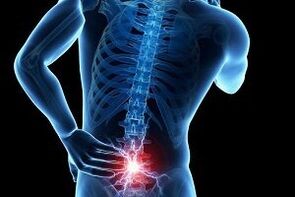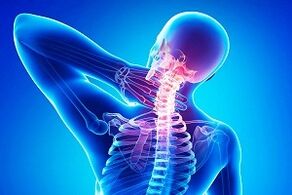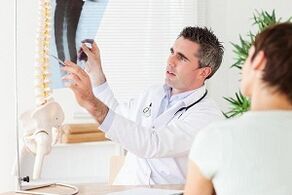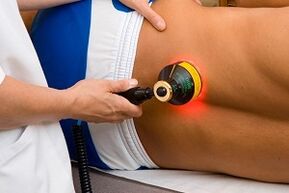
Osteochondrosis is a pathology of the spine that millions of all ages face.
Degenerative and dystrophic lesions in the intervertebral discs, proliferation of osteophytes cause pain syndrome, reduce the mobility of the supporting column. The symptoms depend on the area affected.
In most cases, the negative manifestations not only affect the supporting column and the paravertebral zone, but also spread to other areas.
In the absence of treatment, the disease progresses, organs and systems are disrupted, health is noticeably deteriorating, and persistent pain and complications in the background of the pathology can lead to disability.
It is important to know what osteochondrosis is, the causes of common disease, and methods of treatment and prevention.
Causes of the disease

Degenerative and dystrophic processes in the intervertebral discs, excessive ossification in the affected area develops in the following cases:
- back injuries;
- high loads on the support column during hard work, professional sports, loads;
- congenital defects of the support column;
- lack of vitamins, minerals, deterioration of the quality of the pillow;
- violation of mineral metabolism;
- hormonal disorders, endocrine diseases;
- lack of movement, sedentary work;
- severe obesity;
- decreased elasticity of intervertebral discs in old age as the body ages;
- excessive consumption of strong coffee, carbonated and alcoholic beverages, sour foods, smoked meats, smoking;
- tumor process in the paravertebral zone that causes damage to the elastic structures of the spine.
Types and sections
Osteochondrosis affects all parts of the support column. Degenerative processes are more active in the mobile regions: damage to the lumbar and cervical, thoracic vertebrae, and bone tissue is less common.
There are several types of osteochondrosis, depending on the area affected:
- cervical;
- chest;
- lumbosacral.
Stages of pathology:
- First phase- development of chondrosis. Lack of nutrients degrades the quality of the disc and reduces the elasticity of the pillow. High load in the background of thinning of cartilage tissue causes mild to moderate pain in the spine;
- second stage.The deformations of the elastic structures are more pronounced, the pain appears not only during the loads, but also during bending and turning. The defeat of the annulus fibrosus leads to pinching of sensitive structures, greater friction of bone elements;
- third stage.The integrity of the anulus fibrosus is broken, the disc extends beyond the vertebrae, the pain syndrome is pronounced. It is difficult for a patient to be without medication to reduce discomfort. Against the background of the destruction of the elastic pad, the mobility of the support column decreases, protrusions and intervertebral hernia develop;
- fourth stage.The cartilage layer is virtually absent, and osteophytes appear on the spine. Bone growth tries to compensate for the overload on the affected vertebrae. The dense elements stabilize the ridge while reducing the mobility of the problem area of the support column. In the fourth stage of osteochondrosis, the pain is weakened, but the patient has difficulty performing simple movements. If changes occur in the lumbosacral area, paresis or paralysis of the lower body may occur. Often, in the fourth stage of osteochondrosis, the patient diagnoses a disability.
For a note!Supportive column disease occurs with periods of remission (several months to a year or more) and exacerbations (duration of relapse, severity of pain depending on a number of factors).
The first signs and symptoms

The onset of the disease depends on the stage and the stage involved.
The more negative factors, the greater the risk of pain syndrome, damage to other areas.
Blood circulation deteriorates, mineral metabolism is impaired, protrusions, vertebral arteries develop, and excessive ossification occurs in the affected area.
Self-healing, lack of skilled help, and reluctance to visit the vertebrologist regularly negatively affect the structure of the vertebrae.
Cervical
The main signs are:
- radical syndrome with severe disc damage;
- pain in the back of the head, neck, crown;
- dizziness, fainting;
- headache;
- discomfort in the muscles of the shoulder, neck;
- numbness of the neck area, hands, fingers;
- discomfort in the chest area;
- impairment of cervical spine mobility;
- decreased or lost shoulder muscle reflexes;
- "goosebumps" feeling in the hands, fingers;
- in osteochondrosis of the cervical spine, a person is tormented by insomnia, depressive states, irritability in the painful or painful background of the neck and head.
Chest osteochondrosis
Typical signs:
- long stay in one position, high loads, turns, bends, chest pain appear;
- with deep breathing, discomfort of varying intensity can be felt in the middle of the back;
- when the arms are raised, the pain increases when the body is moved;
- as osteochondrosis of the thoracic region progresses, problems occur in the work of the digestive system;
- discomfort in the hands "goosebumps";
- depending on the extent of the injury, doctors distinguish between dorsalgia - painful sensations in the affected spine and dorsal - acute, excruciating, high-intensity pain that restricts breathing, causing muscle cramps;
- intercostal neuralgia develops;
- painful or acute pain in the shoulder blades;
- reproductive disorders occur.
Lumbosacral region

The main symptoms are:
- discomfort of varying intensity in the lower back;
- muscle weakness, development of paresis;
- coldness and numbness of the lower extremities;
- pain syndrome expressed by severe exertion or exertion;
- painful lumbar lumbago appears: pain radiates from the lower back to the gluteal zone, groin, legs;
- intermittent bruising develops;
- nerve compression adversely affects the work of pelvic organs: severe lumbosacral osteochondrosis, urinary incontinence, involuntary defecation;
- fatigue appears, it is difficult to stand, long walking causes weakness in the legs.
Diagnostics
You should contact a vertebrologist to clarify the condition of your spine. In the absence of a physician for this course, you should see a neurologist or orthopedic traumatologist.
Diagnostic measures:
- Examination of the patient, examination of complaints.
- MRI.
- CT.
- X-ray of the spine in several projections.
- Doppler ultrasound of blood vessels.
- Electromyography.
Effective treatments
How to treat osteochondrosis? Chronic pathology requires attention from both the physician and the patient. Do not expect the negative symptoms to disappear one week after the start of therapy. Only an integrated approach will work. The patient should understand that the drugs alone cannot eliminate degenerative-dystrophic lesions of the plates, prevent the proliferation of osteophytes.

To successfully treat and prevent osteochondrosis, it is important to:
- perform complex training therapy;
- take part in massage and physiotherapy;
- Healthy food;
- organize work and sleeping areas, taking into account the doctor's recommendations;
- do not lift weights;
- take vitamins, mineral complexes regularly to maintain the flexibility of the plates, the strength of bone tissue;
- refuses to train too intensely;
- avoid back injuries and bruises;
- watch your weight.
There are other important rules:
- do not overcool;
- treat pathologies that adversely affect the condition of the plates;
- take breaks, warm up while working on the computer;
- move more, do physical education;
- stop excessive coffee and alcohol consumption, forget smoking;
- avoid prolonged static / dynamic loads;
- sleep on an orthopedic mattress and low pillow;
- less nervous;
- spend at least 7 hours a night sleeping;
- visit a vertebrologist regularly to check the condition of your vertebral structures.
Medicines
Effective groups and names:
- chondroprotectors. . . They restore cartilage tissue, slowing down the process of destroying the plates. Course - 4 months or more;
- NSAIDs. . . Medications relieve pain, eliminate swelling and inflammation. Local remedies have a good effect: ointments, gels, plasters;
- Vitamins B.. . . Medications restore nerve regulation, improve the nutrition of nerve cells, and reduce the power of pain syndrome. Injections (in the first days, during exacerbation) and tablets (for long-term treatment and prevention) are effective;
- muscle relaxants. . . The devices cope with muscle cramps, which are the main causes of nerve endings;
- compositions that normalize blood circulation.Most commonly, drugs in this group are prescribed for cervical osteochondrosis, against which the brain suffers;
- spinal obstructions, injection in the paravertebral zone. This type of exposure helps with the excruciating lumbago and pain in the background of nerve stings in the third or fourth stage of osteochondrosis. To enhance the effect, corticosteroids and excipients are added to the analgesics;
- drugs of the GCS group.Steroid preparations are essential for severe pain. Injections are often prescribed for lumbosacral osteochondrosis with a painful lumbago background.
Exercise and gymnastics
After relieving the acute pain and alleviating the inflammatory process, neck, lumbosacral and chest exercises are prescribed. Doctors have developed a complex training therapy for each zone with varying degrees of stress.
The first sessions are led by a physiotherapist. After studying the complex, the patient resumes training at home. In order to achieve a therapeutic effect, it is important to monitor the duration and frequency of sessions. In addition to physical education, vertebrologists advise you to go to the pool: swimming is an ideal type of positive effect on the spine.
Physiotherapy procedures

Effective modes of action:
- ozokerite applications;
- laser therapy;
- radon and turpentine baths;
- shock wave therapy;
- electrical processes;
- mud therapy;
- phonophoresis and electrophoresis with drugs;
- magnetotherapy.
The following methods have a good effect in the treatment of osteochondrosis:
- acupuncture;
- hirudotherapy;
- reflexology;
- using a needle applicator;
- manual therapy;
- dry and underwater traction of the spine;
- medical applicator.
It is quite difficult to prevent the development of osteochondrosis, but doctors advise you to remember the factors that cause dystrophic and degenerative processes in the structure of the vertebrae. The more a person pays attention to a healthy lifestyle, the lower the risk of negative changes in the intervertebral discs.

















































